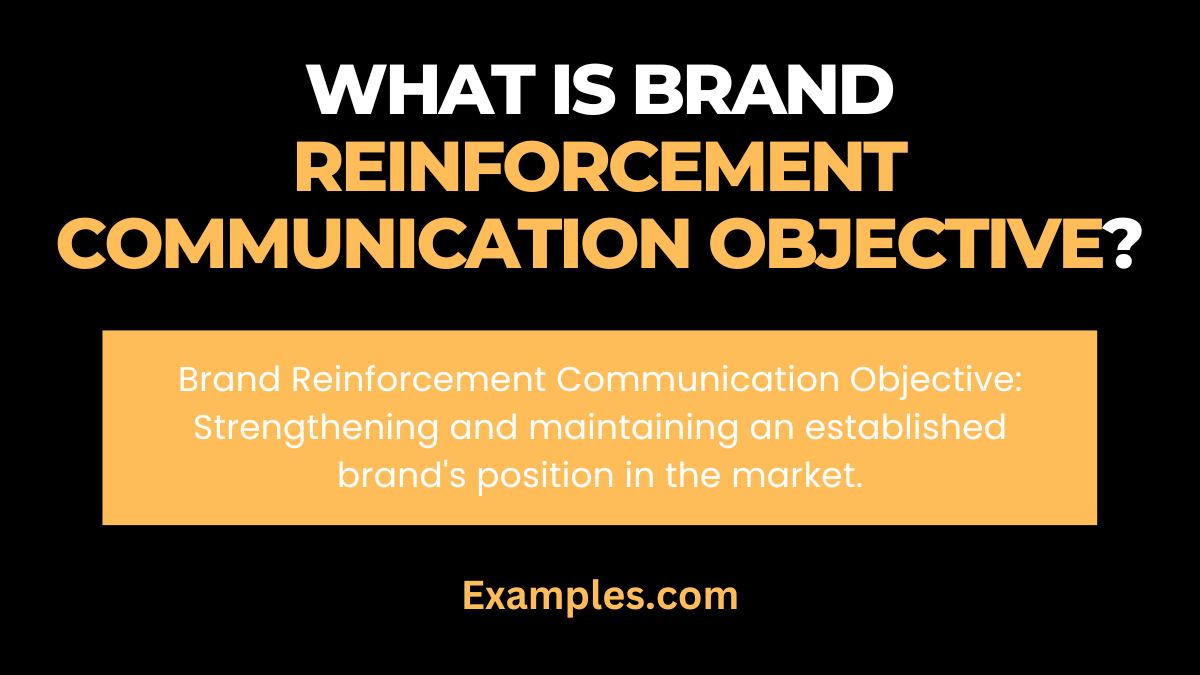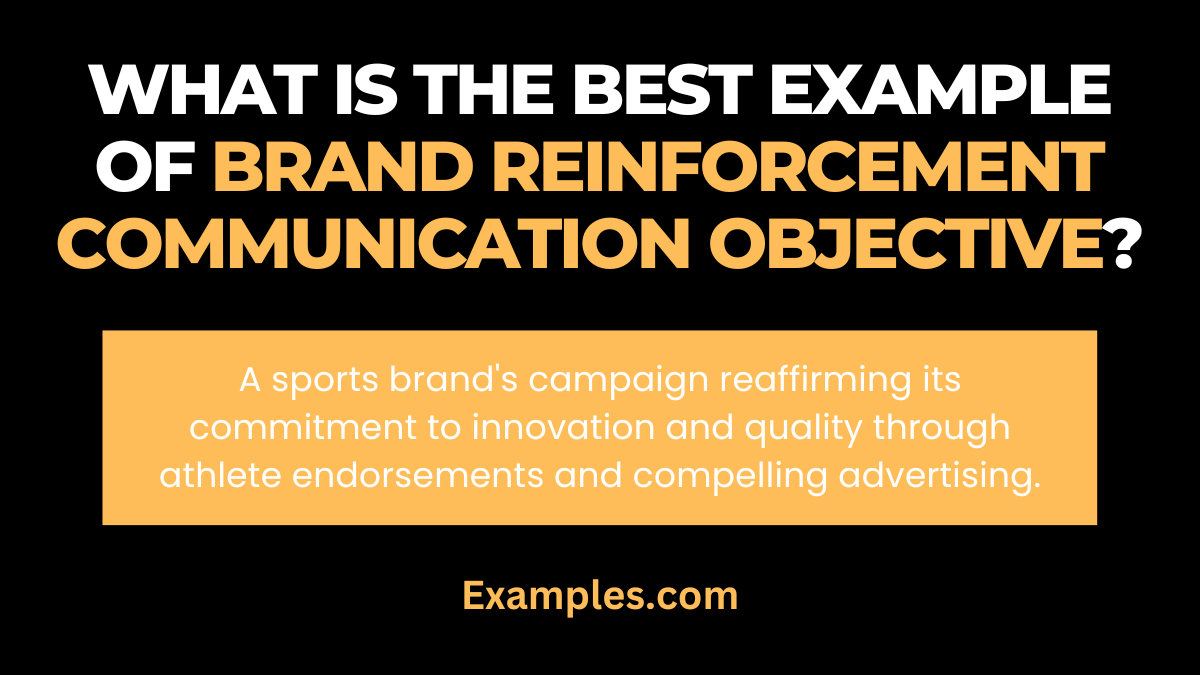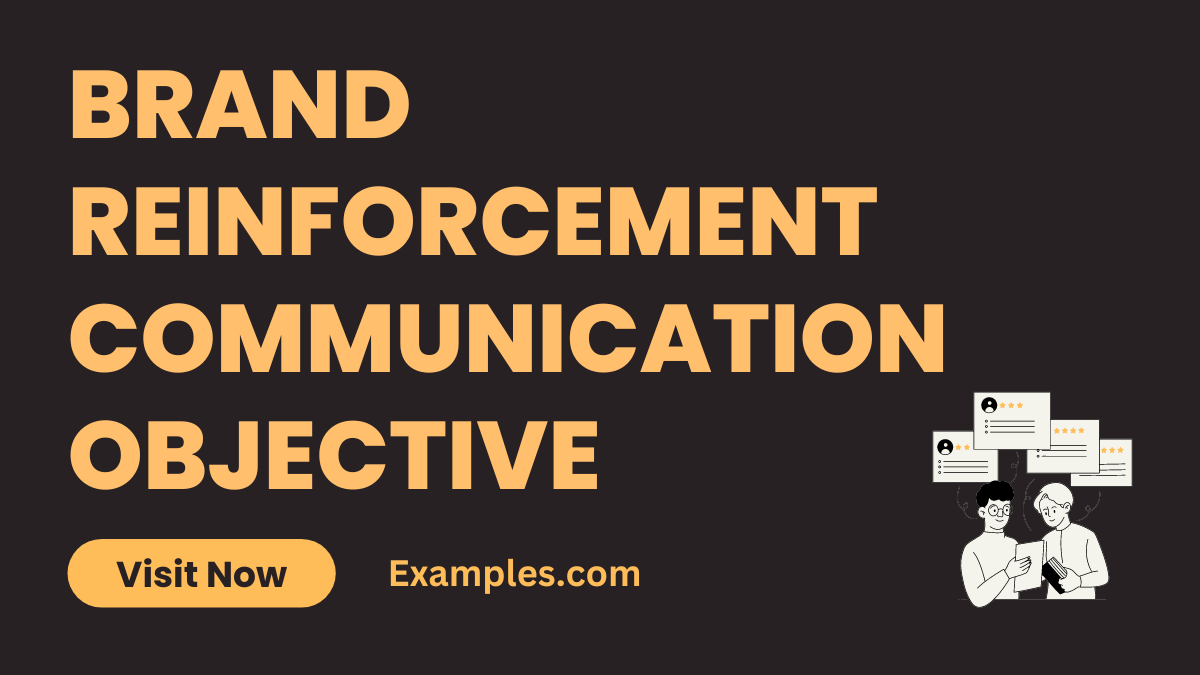19+ Brand Reinforcement Communication Objective Examples
The Brand Reinforcement Communication Objective is crucial in maintaining and enhancing the strength of a brand’s presence in the market. This objective involves strategically communicating the brand’s values, strengths, and unique selling propositions to ensure consistent brand perception. Reinforcing a brand effectively requires a deep understanding of the target audience and consistent messaging across all Communication Objectives. It’s not just about maintaining visibility; it’s about strengthening the emotional and psychological ties consumers have with the brand.
What is Brand Reinforcement Communication Objective?

A Brand Reinforcement Communication Objective focuses on strengthening and consolidating an existing brand’s position in the market. It involves reminding or reinforcing the brand’s value proposition to the existing customer base and potential customers. This objective is not about changing the brand message but about consistently reiterating and reinforcing the established brand image and values, ensuring they remain fresh and relevant in the minds of the audience.
What is the Best Example of Brand Reinforcement Communication Objective?

An excellent example of a Brand Reinforcement Communication Objective is a campaign by a well-known sports brand emphasizing its long-standing commitment to innovation and quality in sports apparel. The campaign uses athlete endorsements, social media, and visually compelling advertising to remind consumers of the brand’s legacy and ongoing commitment to excellence, thus reinforcing the brand’s strong identity and market position.
20 Brand Reinforcement Communication Objective Examples

Brand reinforcement is a vital communication objective, focusing on strengthening a brand’s position and presence in the market. This objective involves consistently communicating the brand’s values, qualities, and benefits to ensure it remains top-of-mind for consumers. Through various channels and strategies, brand reinforcement aims to build loyalty, trust, and a strong emotional connection with the audience, ensuring long-term brand success and customer engagement.
- Emphasizing Quality in Product Advertising: Highlighting the superior quality of products in communications.
Example: “Experience the unmatched quality that sets our products apart.” - Showcasing Brand Heritage in Marketing: Using the brand’s history and legacy in messaging.
Example: “Our rich heritage is the foundation of our exceptional products.” - Highlighting Customer Satisfaction in Campaigns: Focusing on positive customer experiences and testimonials.
Example: “Join our community of satisfied customers and enjoy the difference.” - Promoting Brand Values in Social Media: Regularly sharing content that reflects core brand values.
Example: “Our commitment to sustainability is at the heart of everything we do.” - Reinforcing Brand Identity in Visuals: Ensuring consistent use of brand colors, logos, and style.
Example: “Our distinctive design and branding are symbols of our commitment to excellence.” - Leveraging Influencer Partnerships: Collaborating with influencers who align with the brand’s image.
Example: “In partnership with influencers who share our passion for quality.” - Consistent Messaging Across Platforms: Maintaining a unified brand voice on all channels.
Example: “Wherever you find us, you’ll hear our unique brand voice.” - Utilizing Brand Storytelling: Telling compelling stories that resonate with the brand’s identity.
Example: “Every product has a story, and ours is one of innovation and dedication.” - Engaging in Community Initiatives: Participating in community events that align with brand values.
Example: “We’re more than a brand; we’re part of your community.” - Promotional Offers Reflecting Brand Image: Creating offers that reinforce the brand’s premium image.
Example: “Exclusive offers that match the exclusivity of our brand.” - Content Marketing with Brand Themes: Developing content that consistently reflects the brand’s themes.
Example: “Our blog features topics that resonate with our brand philosophy.” - Brand Loyalty Programs: Implementing loyalty programs that emphasize brand value.
Example: “Join our loyalty program and be part of our brand’s journey.” - Customer Service Excellence: Delivering customer service that upholds the brand’s reputation.
Example: “Experience customer service that’s as exceptional as our products.” - Highlighting Innovations and Advancements: Communicating the brand’s continual growth and innovation.
Example: “Innovation is at the core of our brand’s evolution.” - Environmental Responsibility Messaging: Aligning the brand with environmental sustainability initiatives.
Example: “We’re committed to sustainability in every aspect of our brand.” - Employee Advocacy Programs: Encouraging employees to be ambassadors of the brand.
Example: “Our employees are the strongest advocates of our brand’s excellence.” - Brand Partnership Announcements: Collaborating with brands that enhance and complement the brand image.
Example: “Our new partnerships reflect our dedication to quality and excellence.” - Corporate Social Responsibility (CSR) Communications: Using CSR activities to reinforce brand values.
Example: “Our CSR initiatives are a testament to our brand’s commitment to society.” - Celebrating Milestones and Achievements: Marking brand achievements in communications.
Example: “Celebrating our milestones with you, our valued customers.” - Regular Updates on Product Development: Keeping the audience informed about new developments.
Example: “Stay tuned for the latest innovations from our brand.”
Each of these examples showcases how strategic communication can effectively reinforce a brand’s presence and strengthen its relationship with its audience.
Brand Reinforcement Communication Objective in Marketing
Brand Reinforcement Communication Objectives in marketing are essential for maintaining and enhancing a brand’s reputation and presence in the market. These objectives focus on consistently reminding the audience of the brand’s value, quality, and uniqueness, ensuring the brand remains top-of-mind and relevant.
- Emphasizing Unique Selling Propositions (USPs): Highlighting what sets the brand apart.
- Consistent Brand Messaging: Maintaining a uniform message across all platforms.
- Leveraging Customer Testimonials: Using customer experiences to reinforce brand trust.
- Utilizing Social Media Effectively: Engaging with customers on social platforms.
- Incorporating Influencer Partnerships: Collaborating with influencers to strengthen brand presence.
- Content Marketing for Brand Storytelling: Using content to share the brand’s story.
- Email Marketing for Personalized Engagement: Sending targeted emails to reinforce brand messages.
- Loyalty Programs to Encourage Repeat Business: Building loyalty through rewards and incentives.
- Seasonal Campaigns to Stay Relevant: Aligning marketing efforts with current events or seasons.
- Public Relations to Enhance Brand Image: Using PR to positively influence brand perception.
Effective brand reinforcement in marketing requires a strategic and consistent approach to ensure long-term brand loyalty and success.
Brand Reinforcement Communication Objective in Resume
Incorporating Brand Reinforcement Communication Objectives in a resume can significantly enhance a candidate’s appeal, especially in marketing and communication roles. It highlights a candidate’s ability to maintain and grow a brand’s strength through strategic communication.
- Showcasing Brand Management Skills: Highlighting experience in managing and growing brand equity.
- Examples of Successful Brand Campaigns: Demonstrating impact through past campaigns.
- Quantifying Achievements in Brand Growth: Using metrics to show the success of brand initiatives.
- Skills in Multichannel Brand Communication: Showcasing ability to manage brand messaging across various channels.
- Experience in Customer Engagement Strategies: Demonstrating skills in building customer relationships.
- Innovative Branding Ideas and Implementation: Presenting creative approaches to brand communication.
- Leadership in Brand Strategy Development: Highlighting leadership roles in brand strategy.
- Expertise in Digital Branding Techniques: Showcasing knowledge in digital branding.
- Evidence of Continuous Brand Improvement: Demonstrating a commitment to evolving the brand.
- Success Stories in Rebranding Efforts: Sharing experiences in successfully rebranding.
A resume with a focus on brand reinforcement objectives showcases a candidate’s expertise in strategic brand communication and management.
Importance of Brand Reinforcement Communication Objective
The Importance of Brand Reinforcement Communication Objective lies in its ability to keep a brand strong and relevant in a competitive market. It’s about continuously reminding the audience of the brand’s value and keeping it at the forefront of consumers’ minds.
- Maintains Brand Visibility: Keeps the brand visible in a crowded market.
- Strengthens Customer Loyalty: Reinforces customer’s connection to the brand.
- Supports Long-Term Business Growth: Contributes to the longevity and success of the business.
- Builds Brand Equity: Enhances the overall value of the brand.
- Facilitates Trust and Credibility: Strengthens the brand’s trustworthiness and credibility.
- Aids in Competitive Differentiation: Helps the brand stand out from competitors.
- Encourages Repeat Business: Fosters customer retention and repeat purchases.
- Supports New Product Launches: Creates a solid foundation for introducing new products.
- Enhances Corporate Reputation: Positively impacts the overall corporate image.
- Drives Consistent Messaging: Ensures consistent brand communication across all platforms.
Brand reinforcement is crucial for ensuring that a brand remains a preferred choice for consumers, influencing both their current and future purchasing decisions.
The Brand Reinforcement Communication Objective is a critical component in maintaining and strengthening a brand’s market position. Whether in marketing strategies, resumes, or overall brand management, effective brand reinforcement communication ensures that the brand remains prominent, credible, and appealing to its target audience. This guide underscores the significance of consistent and strategic communication in reinforcing a brand’s image, contributing significantly to its long-term success and sustainability.



